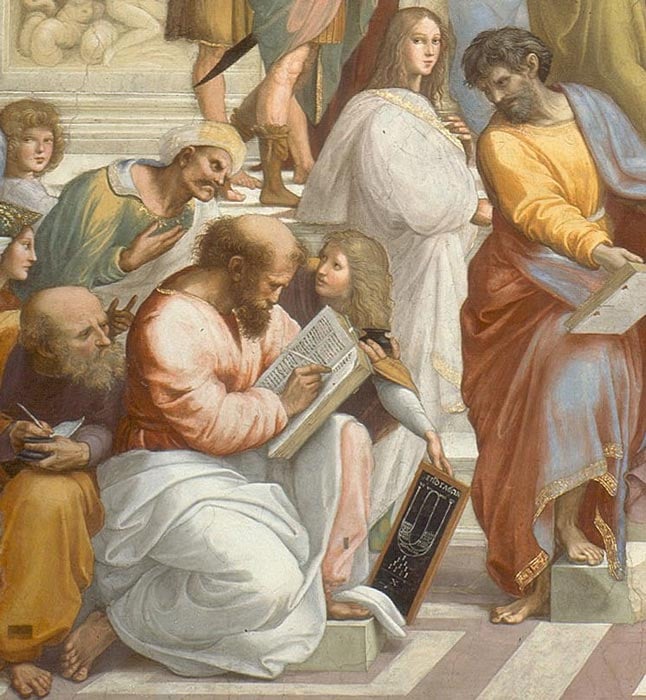Archytas was an ancient Greek philosopher, who was born in 428 BC in Tarentum, Magna Graecia, now southern Italy. In addition to being a philosopher, Archytas was also a mathematician, astronomer, statesman, and a strategist, best remembered for inventing what is believed to be the first-ever self-propelled flying device known as the Flying Pigeon.

Archytas became a Pythagorean, fascinated by arithmetic, mathematics and geometry. Raphael’s fresco, The School of Athens, shows Pythagoras as a young man. ( Public domain )
Explaining the World Through Mathematics
When Archytas was young, he was taught by Philolaus. Over time he became a Pythagorean, believing that only arithmetic could provide a basis for satisfactory proofs, and that this could not be accomplished via geometry. He even taught mathematics to Eudoxus of Cnidus and Menaechmus.
To Archytas, everything revolved around and could be explained by mathematics. He viewed mathematics as being broken into four branches: geometry, arithmetic, astronomy and music. In a preface to one of his writings (identified by some as “On Mathematics” and others as “On Harmonics”), Archytas wrote:
Mathematicians seem to me to have excellent discernment, and it is not at all strange that they should think correctly about the particulars that are; for inasmuch as they can discern excellently about the physics of the universe, they are also likely to have excellent perspective on the particulars that are. Indeed, they have transmitted to us a keen discernment about the velocities of the stars and their risings and settings, and about geometry, arithmetic, astronomy, and, not least of all, music. These seem to be sister sciences, for they concern themselves with the first two related forms of being [number and magnitude].
Archytas served well in leadership positions. At one point, the Pythagoreans were attacked and expelled from Magna Graecia , with the town of Tarentum left as their only relative safe house. Archytas became a leader of the Pythagoreans in Tarentum, and tried to unite the Greek towns in their area to form an alliance against non-Greek neighbors.
Although under Tarentum law one person could only hold the post of commander-in-chief for one year, Archytas was elected into the position for seven consecutive years. During this time he was close friends with Plato, and it is believed that he saved Plato’s life at one time.

Archytas and his steam-powered flying pigeon. ( Archivist / Adobe Stock)
Archytas and his Steam-Powered Flying Pigeon
It is said that Archytas’ most important contribution was that he was the founder of mathematical mechanics. He was the inventor of what is known as “the first autonomous volatile machine of antiquity” – or the flying pigeon to put it simply.
Archytas’ steam-powered flying pigeon was a highly advanced invention for his time. It was called the flying pigeon because its structure resembled a bird in flight. It was built of wood, and was one of the first attempts to understand the way in which birds manage to fly.
The lightweight body of the flying pigeon was hollow and cylindrical in shape. It included wings projected out to either side, and smaller wings to the rear. The front of the object was pointed, like a bird’s beak. The shape of the structure was very aerodynamic, for maximum flying distance and speed.
![]()
Meanwhile, the rear of the flying pigeon had an opening that led to the internal bladder. This opening was connected to a heated, airtight boiler. As the boiler created more and more steam, the pressure of the steam eventually exceeded the mechanical resistance of the connection, and the flying pigeon took flight. The flight continued for several hundred meters.
Invented some time between 400 and 350 BC, the steam-powered flying pigeon created by Archytas is sometimes referred to as the world’s first robot. It’s also the first instance on record of research into how birds fly. The Kotsanas Musem of Ancient Greek Technology has created a reconstruction of what the flying pigeon would have looked like.

Reconstruction of the steam-powered flying pigeon. ( Kotsanas Musem of Ancient Greek Technology )
The Death and Legacy of Archytas
It is believed that Archytas died in a shipwreck in 347 BC near the shore of Mattinata. His body lay unburied until a sailor cast a handful of sand upon it, so that Archytas would not have to wander on this side of the Styx for a hundred years. This story was never verified.